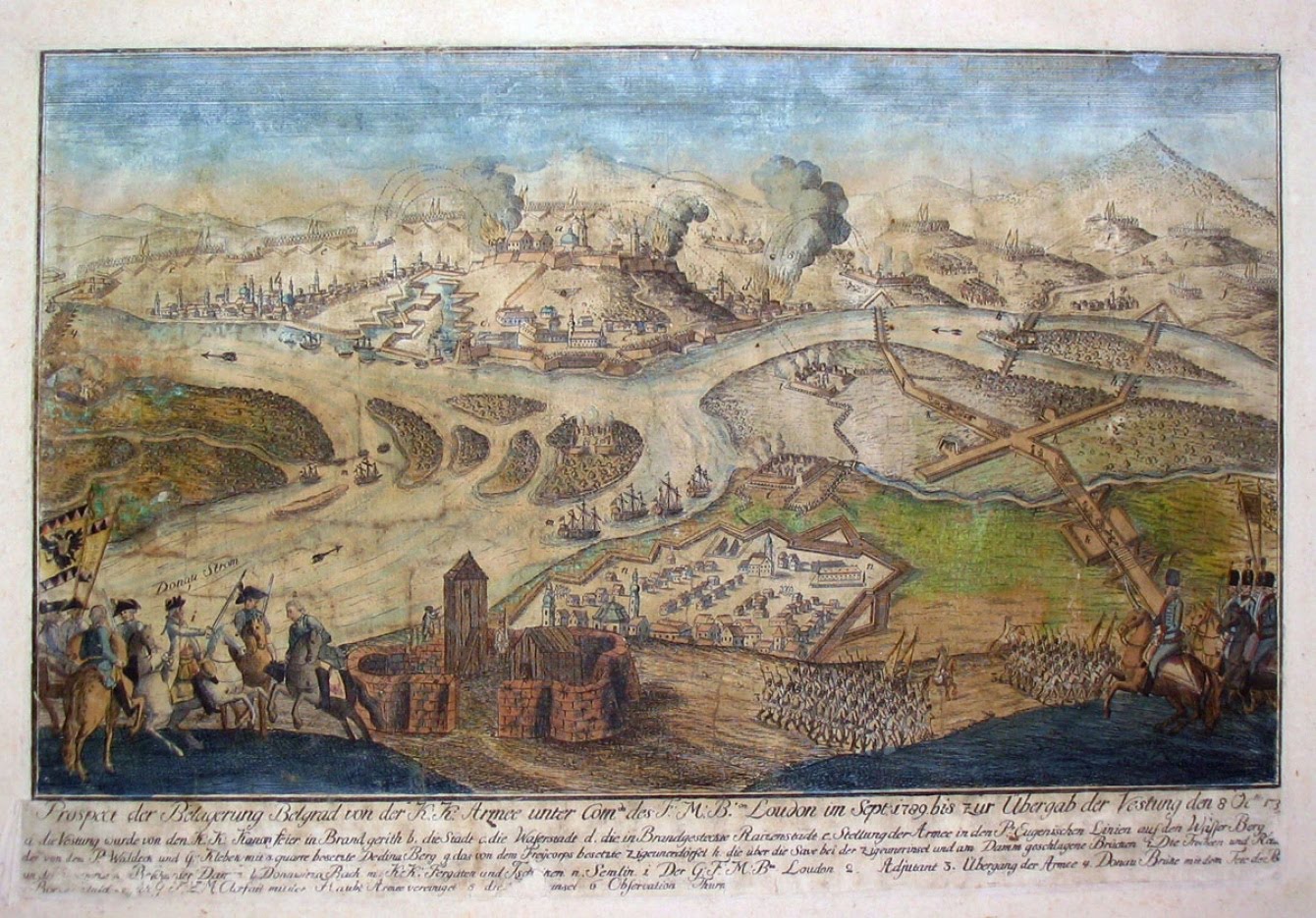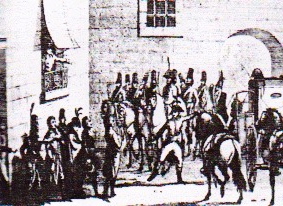|
Karl Freiherr Mack Von Leiberich
Karl Freiherr Mack von Leiberich (25 August 1752 – 22 December 1828) was an Austrian soldier. He is best remembered as the commander of the Austrian forces that capitulated to Napoleon's ''Grande Armée'' in the Battle of Ulm in 1805. Early career Karl Leiberich was born at Nennslingen, in the Principality of Ansbach. In 1770 he joined an Austrian cavalry regiment, in which his uncle, Leiberich, was a squadron commander, becoming an officer seven years later. During the brief War of the Bavarian Succession he was selected for service on the staff of Count Kinsky, under whom, and subsequently under the commander-in-chief Field Marshal Count Lacy, he did excellent work. He was promoted first lieutenant in 1778, and captain on the quartermaster-general's staff in 1783. Count Lacy, then the foremost soldier of the Austrian army, had the highest opinion of his young assistant. In 1785 Mack married Katherine Gabrieul, and was ennobled under the name of Mack von Leiberich. In the Tur ... [...More Info...] [...Related Items...] OR: [Wikipedia] [Google] [Baidu] |
Nennslingen
Nennslingen is a municipality in the Weißenburg-Gunzenhausen district, in Bavaria, Germany Germany,, officially the Federal Republic of Germany, is a country in Central Europe. It is the second most populous country in Europe after Russia, and the most populous member state of the European Union. Germany is situated betwe .... References Weißenburg-Gunzenhausen {{WeißenburgGunzenhausen-geo-stub ... [...More Info...] [...Related Items...] OR: [Wikipedia] [Google] [Baidu] |
Siege Of Belgrade (1789)
In the siege of Belgrade (15 September – 8 October 1789) a Habsburg Austrian army led by Feldmarschall Ernst Gideon von Laudon besieged an Ottoman Turkish force under Osman Pasha in the fortress of Belgrade. After a three-week leaguer, the Austrians forced the surrender of the fortress. During the campaign which was part of the Austro-Turkish War, the Austrian army was greatly hampered by illness. Austria held the city until 1791 when it handed Belgrade back to the Ottomans according to the terms of the peace treaty. Several Austrian soldiers who distinguished themselves during the siege later held important commands in the subsequent French Revolutionary Wars and Napoleonic Wars. Belgrade is the capital of modern Serbia. At the urging of Russian Empress Catherine the Great, Joseph II, Holy Roman Emperor committed the Habsburg monarchy to a war against Ottoman Turkey. In 1788, the Austrians captured one fortress and seized some territory but most of their efforts were thwarted. ... [...More Info...] [...Related Items...] OR: [Wikipedia] [Google] [Baidu] |
Napoleon
Napoleon Bonaparte ; it, Napoleone Bonaparte, ; co, Napulione Buonaparte. (born Napoleone Buonaparte; 15 August 1769 – 5 May 1821), later known by his regnal name Napoleon I, was a French military commander and political leader who rose to prominence during the French Revolution and led successful campaigns during the Revolutionary Wars. He was the ''de facto'' leader of the French Republic as First Consul from 1799 to 1804, then Emperor of the French from 1804 until 1814 and again in 1815. Napoleon's political and cultural legacy endures to this day, as a highly celebrated and controversial leader. He initiated many liberal reforms that have persisted in society, and is considered one of the greatest military commanders in history. His wars and campaigns are studied by militaries all over the world. Between three and six million civilians and soldiers perished in what became known as the Napoleonic Wars. Napoleon was born on the island of Corsica, not long af ... [...More Info...] [...Related Items...] OR: [Wikipedia] [Google] [Baidu] |
Feldmarschall-leutnant
Lieutenant field marshal, also frequently historically field marshal lieutenant (german: Feldmarschall-Leutnant, formerly , historically also and, in official Imperial and Royal Austrian army documents from 1867 always , abbreviated ''FML''), was a senior army rank in certain European armies of the 17th to 20th centuries. It emerged as the rank of field marshal (german: Feldmarschall) came to be used for the highest army commander in the 17th century (having originally been the equivalent of a cavalry colonel). In German-speaking countries the commander-in-chief usually appointed an "under marshal" () or "lieutenant field marshal" to support and represent the field marshal. Amongst his functions as the personal deputy to the field marshal, were the supervision of supply depots and routes, and inspection of the guards. Austria It was introduced to the Army of the Austrian Empire in the period 1804 to 1866, and the Austro-Hungarian Army from 1867 to 1918, where it was the second ... [...More Info...] [...Related Items...] OR: [Wikipedia] [Google] [Baidu] |
Francis II, Holy Roman Emperor
Francis II (german: Franz II.; 12 February 1768 – 2 March 1835) was the last Holy Roman Emperor (from 1792 to 1806) and the founder and Emperor of the Austrian Empire, from 1804 to 1835. He assumed the title of Emperor of Austria in response to the coronation of Napoleon as Emperor of the French. Soon after Napoleon created the Confederation of the Rhine, Francis abdicated as Holy Roman Emperor. He was King of Hungary, Croatia and Bohemia. He also served as the first president of the German Confederation following its establishment in 1815. Francis II continued his leading role as an opponent of Napoleonic France in the Napoleonic Wars, and suffered several more defeats after the Battle of Austerlitz. The marriage of his daughter Marie Louise of Austria to Napoleon on 10 March 1810 was arguably his severest personal defeat. After the abdication of Napoleon following the War of the Sixth Coalition, Austria participated as a leading member of the Holy Alliance at the Congress ... [...More Info...] [...Related Items...] OR: [Wikipedia] [Google] [Baidu] |
Cuirassier
Cuirassiers (; ) were cavalry equipped with a cuirass, sword, and pistols. Cuirassiers first appeared in mid-to-late 16th century Europe as a result of armoured cavalry, such as men-at-arms and demi-lancers, discarding their lances and adopting the use of pistols as their primary weapon. In the later part of the 17th century the cuirassier lost his limb armour and subsequently wore only the cuirass (breastplate and backplate), and sometimes a helmet. By this time, the sword or sabre had become his primary weapon, with pistols relegated to a secondary function. Cuirassiers achieved increased prominence during the Napoleonic Wars and were last fielded in the opening stages of World War I (1914-1918). A number of countries continue to use cuirassiers as ceremonial troops. The French term ''cuirassier'' means "one with a cuirass" ( fr , cuirasse), the breastplate armour which they wore. 16th and 17th centuries The first cuirassiers were similar in appearance to the fully armou ... [...More Info...] [...Related Items...] OR: [Wikipedia] [Google] [Baidu] |
Inhaber
A Proprietor, or Inhaber, was a term used in the Habsburg military to denote special honors extended to a noble or aristocrat. The Habsburg army was organized on principles developed for the feudal armies in which regiments were raised by a wealthy noble, called the ''Inhaber'' (proprietor) who also acted as honorary colonel. Originally, he raised the regiment, funded its needs, and received a portion of its revenue, which might be plunder or loot. He also shared in its shame or its honors. The Prussian and Imperial Russian military adopted a similar system. Practical application When the ''Inhaber'' was a famous or royal person, a second colonel was chosen from among the nobility to perform his duties. For example, on 16 September 1789, Friedrich Joseph, Count of Nauendorf, led a successful raid on the island of Borecs in the Danube, which garnered massive amounts of supplies from the Turkish forces. On 9 November of that year, he led four squadrons of his regiment to ... [...More Info...] [...Related Items...] OR: [Wikipedia] [Google] [Baidu] |
Charles François Dumouriez
Charles-François du Périer Dumouriez (, 26 January 1739 – 14 March 1823) was a French general during the French Revolutionary Wars. He shared the victory at Valmy with General François Christophe Kellermann, but later deserted the Revolutionary Army, and became a royalist intriguer during the reign of Napoleon as well as an adviser to the British government. Dumouriez is one of the names inscribed under the Arc de Triomphe, on Column 3. Early life Dumouriez was born in Cambrai, on the Scheldt River in northern France, to parents of noble rank. His father, Antoine-François du Périer, served as a commissary of the royal army, and educated his son most carefully and widely. The boy continued his studies in Paris at the ''Lycée Louis-le-Grand'', and in 1757 began his military career as a volunteer in the campaign of Rossbach, where he served as a cornet in the ''Régiment d'Escars''. He received a commission for good conduct in action, and served in the later German cam ... [...More Info...] [...Related Items...] OR: [Wikipedia] [Google] [Baidu] |
Battle Of Neerwinden (1793)
The Battle of Neerwinden (18 March 1793) saw a Republican French army led by Charles François Dumouriez attack a Coalition army commanded by Prince Josias of Saxe-Coburg-Saalfeld. The Coalition army of the Habsburg monarchy together with a small contingent of allied Dutch Republic troops repulsed all French assaults after bitter fighting and Dumouriez conceded defeat, withdrawing from the field. The French position in the Austrian Netherlands swiftly collapsed, ending the threat to the Dutch Republic and allowing Austria to regain control of its lost province. The War of the First Coalition engagement was fought at Neerwinden, located east of Brussels in present-day Belgium. After Dumouriez's victory at Jemappes in November 1792, the French armies rapidly overran most of the Austrian Netherlands. Rather than driving the Austrians to the west bank of the Rhine River, Dumouriez and the French government became preoccupied with a war with the Dutch Republic. During the breat ... [...More Info...] [...Related Items...] OR: [Wikipedia] [Google] [Baidu] |
Battle Of Aldenhoven (1793)
The Battle of Aldenhoven (1 March 1793) saw the Habsburg Austrian army commanded by Prince Josias of Saxe-Coburg-Saalfeld attack a Republican French force under René Joseph de Lanoue. The Austrians successfully crossed the Roer River and engaged in a cavalry charge led by Archduke Charles, Duke of Teschen which routed the French and inflicted heavy losses. The War of the First Coalition battle occurred near Aldenhoven, a city in North Rhine-Westphalia, Germany located about west of Cologne. After a victory in the Battle of Jemappes on 6 November 1792, the French army of Charles Francois Dumouriez conquered most of the Austrian Netherlands. That winter, Dumouriez attempted to overrun the Dutch Republic while Francisco de Miranda besieged Maastricht, covered by Lanoue's troops along the Roer. Sent by the Austrian government to reconquer Belgium, Coburg's troops attacked early on the morning of 1 March and dispersed the French. The Battle of Neerwinden on the 18th of March ... [...More Info...] [...Related Items...] OR: [Wikipedia] [Google] [Baidu] |
Archduke Charles Of Austria
Archduke Charles Louis John Joseph Laurentius of Austria, Duke of Teschen (german: link=no, Erzherzog Karl Ludwig Johann Josef Lorenz von Österreich, Herzog von Teschen; 5 September 177130 April 1847) was an Austrian Empire, Austrian field-marshal, the third son of Emperor Leopold II and his wife, Maria Luisa of Spain. He was also the younger brother of Francis II, Holy Roman Emperor. Despite being epilepsy, epileptic, Charles achieved respect both as a commander and as a reformer of the Austrian army. He was considered one of Napoleon I, Napoleon's more formidable opponents and one of the greatest generals of the French Revolutionary Wars. He began his career fighting the revolutionary armies of France. Early in the wars of the First Coalition, he saw victory at Battle of Neerwinden (1793), Neerwinden in 1793, before being defeated at Battle of Wattignies, Wattignies 1793 and Battle of Fleurus (1794), Fleurus 1794. In 1796, as chief of all Austrian forces on the Rhine, Charles ... [...More Info...] [...Related Items...] OR: [Wikipedia] [Google] [Baidu] |



.jpg)


